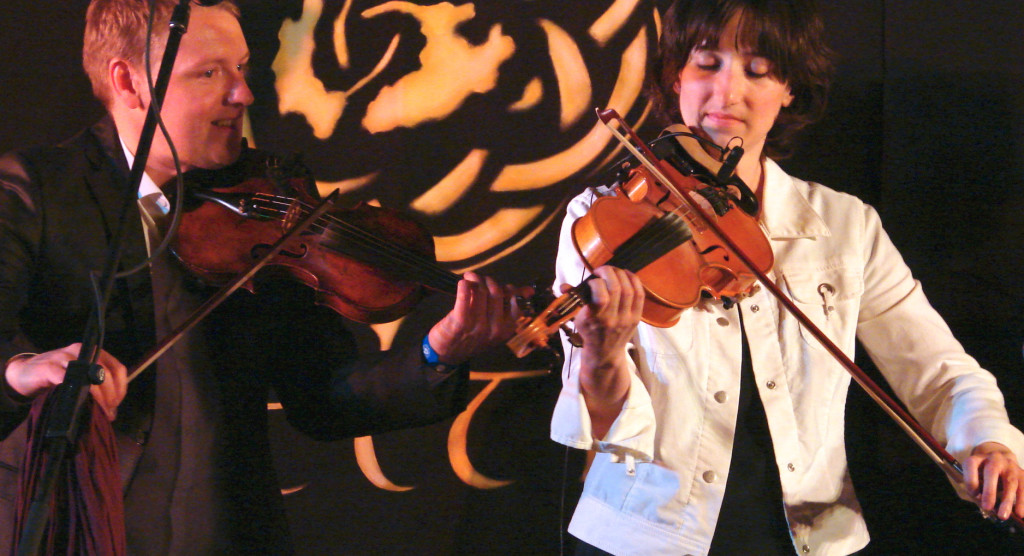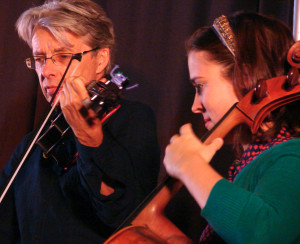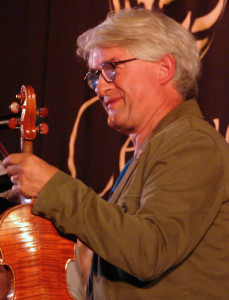It was billed as “Cape Breton meets Denmark via Boston,” and it was all that and more as the two Celtic Colours 2013 Artists in Residence hosted a fiddling extravaganza Sunday night in Wycocomagh on Nova Scotia’s Cape Breton Island. For the two artists in residence — Danish fiddler Harald Haugaard and Cape Breton fiddler Kimberley Fraser — it was a reunion of sorts, too. They shared a bill at the Wycocomagh (wye-COG-uh-muh) Gathering in 2004. Since then, Fraser has gone on to study at the Berklee School of Music in Boston, and although she’s still fairly young, has a finely honed stage presence and a well-developed fiddling style.
The two didn’t appear alone, though. Haugaard brought his current ensemble with him, billed as the Helene Blum & Harald Haugaard Band. Haugaard is a celebrated and award-winning fiddler who has become known world-wide since the 1990s, largely through his partnership with guitarist Morten Alfred Høirup; Blum a popular singer of Danish traditional and contemporary song with an emotive style and crystalline voice. They were backed by a four-piece band that included cello, drums, guitar and mandolin. Fraser is currently working with a hugely talented ensemble that includes one of her fiddling and musical mentors, Darol Anger, as well as sisters Brittany Haas on fiddle and Natalie Haas on cello.
The Fraser-Anger-Haas ensemble is creating some music that I find very exciting, a blend of Celtic, Appalachian and (for want of a better word) “classical” styles. Unlike some such hybrids, this music feels natural and organic. One suite, for example, included the traditional American tune “Polly Put The Kettle On,” the “Cottonwood Reel” which is a traditional Cape Breton Island tune but American in origin, and another unnamed old Cape Breton tune, probably Scottish in origin. The arrangements explore the full dynamic range of the instruments and often feature the players trading lead and backing duties, with Anger frequently providing percussion on his venerable violin. Fraser also got to show off another set of skills, as she demonstrated some Cape Breton-style step-dancing while accompanied by the other three.
The music of the Blum-Haugaard band was mostly less traditional in style. The addition of mandolin, 12-string guitar and especially trap set pushed it into the realm of folk rock at times, and Blum’s vocals and the arrangements approached New Age at others. The Cape Breton crowd, which is accustomed to and appreciates the emotive stylings of Gaelic-language ballads, was receptive, though, and Haugaard also led the ensemble in some more traditional instrumental arrangements to open and close his featured set. His fluid, inventive and playful style was more in evidence in the suites that didn’t feature Blum’s vocals.
The evening began with a short set of enchanting traditional tunes from one of Haugaard’s mentors, Faroese fiddler Peter Uhrbrand, who was backed by Ole Mouritzen on accordion. And as is traditional at Celtic Colours, both the Uhrbrand duo and Fraser’s group came back on stage for a raucous grand finale that had the crowd on its feet, clapping and stomping along to the beat.
The near-sellout crowd at the Wycocomagh Education Centre approached 500 in number. Once again, the sound in this high-ceilinged gymnasium was superb except for a couple of brief instances of feedback from the cello mic. Remember, too, that this was just one of six concerts that took place Sunday night around Cape Breton Island. The others included an evening of ballads at the Gaelic College in St. Ann’s; a candlelight concert of Gaelic, French, Cajun and Cape Breton music at the Louisbourg Fortress; a tribute in tunes and songs to Joe Peter MacLean, a favorite local fiddler who passed away in 2013; tunes and songs from three groups at the Marion Bridge Recreation Centre; and more tunes, songs and stories from four bands in Membertou.
With any luck on Monday I’ll overcome my head-cold symptoms to take in a program in the afternoon at the Bell museum in which Darol Anger and the Haas sisters explore and explain the connections between Appalachian and Celtic styles of traditional music, and then go on to a gathering of fiddlers on the island’s west coast in the community of Judique in the evening. Just another day at the Celtic Colours International Festival.
(Cape Breton Island, Nova Scotia, October 13, 2013)



